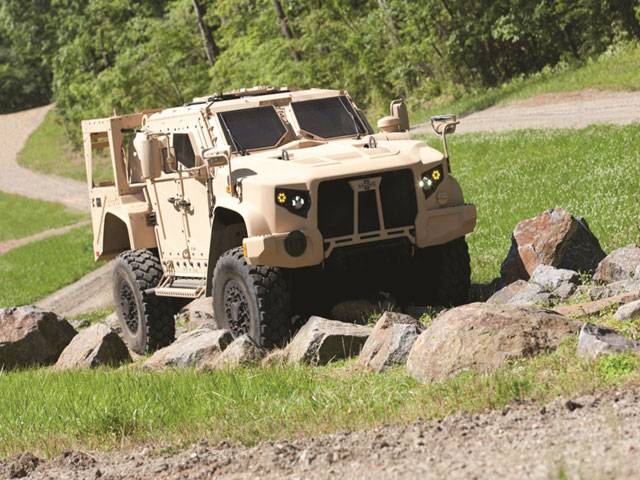Thomas WATKINS
First there was the Jeep, then came the Humvee. Now the US military has a new all-purpose vehicle that’s destined to become another emblem of American fighting power: the JLTV.
Granted, the name is not as catchy as its predecessors, but the Joint Light Tactical Vehicle signals a technological leap forward that the military hopes will protect troops for decades to come.
Army officials last month announced the winner of a bid to replace thousands of Humvees, the culmination of a search that began in the years after the start of the war in Iraq in 2003.
While the beefy-looking Humvee was praised for its speed and ubiquity as invading US troops poured into Iraq, a growing insurgency and the spread of roadside bombs there and in Afghanistan soon spelled trouble for the vehicle - and its occupants.
With a flat underbelly and low clearance, the Humvee was ill-equipped to cope with the deadly blast of an explosive device. Instead of deflecting or dissipating the energy, much of it would shoot into the cab, often with fatal results.
“An armored Humvee is not designed to deal with landmines, the architecture is all wrong,” said Jim Hasick, a senior fellow at the Atlantic Council think tank. “It sits far too close to the ground and doesn’t have a V-shape hull (to deflect a blast).”
The military pushed to reinforce Humvees, but they remained vulnerable. Then came an accelerated program to deliver more than 24,000 new “mine-resistant ambush protected vehicles” - or MRAPs - at a cost of roughly $45 billion.
$6.75 billion contract
But these reinforced trucks were heavy, making it hard to deposit them where they were needed, and running counter to a Pentagon push for a faster, lighter fighting force.
So the military started looking for a replacement vehicle as mobile as a Humvee but with the protection of a MRAP.
The Army on August 25 announced a $6.75 billion contract for the Wisconsin-based manufacturer Oshkosh, which has a long track record of building military trucks and armored vehicles.
Oshkosh beat competitors Lockheed Martin and AM General, which makes the Humvee. The rivals may yet file protests over the contract award, which could potentially trigger delays.
In total, the Army plans to buy nearly 50,000 of the vehicles before 2040, while the Marine Corps wants 5,500. The total value of the contract over that time is estimated at $30 billion, with Oshkosh beginning to deliver vehicles 10 months from now.
Protect the ‘precious cargo’
John Bryant, the senior vice president of defense programs at Oshkosh, said vehicle designers focused on the threat of roadside bombs.
Unlike in a Humvee, parts of the new JLTV fragment so explosive forces are carried away from the cab, helping to dissipate the deadly energy. “Pieces of the vehicle will definitely fly off,” Bryant told AFP.
“They are supposed to behave that way. You can see significant levels of destruction to portions of the vehicle, and yet the crew capsule with that precious cargo inside remains intact - and the crew survives.”
While precise technical specifications remain secret, Bryant said the new vehicle has been designed for the future, meaning it can be readily adapted for changing military needs.
For instance, it can come fitted with a turret for a regular gunner, or else it can be equipped with a remotely operated weapon. Similarly, it would be relatively straightforward to make the vehicle remote-controlled or give it a hybrid-electric engine.
Imagine a convoy of military vehicles: if the leading one is remote-controlled and hits a roadside bomb, there is no crew to get injured.
The Oshkosh JLTV has a hulking front end covering a 6.6-liter diesel engine and small, bulletproof windows.
The vehicle is comparatively speedy, going up to 70 percent faster than any other military vehicle over rough terrain. And it’s light enough to be carried by a CH-47 Chinook helicopter.
Foreign interest
Just as the Humvee was adopted by foreign armies around the world, Bryant said several countries have already expressed an interest in the JLTV. “The requirement for protected mobility combined with extreme off-road capabilities seems to be a relatively universal requirement,” he said.
In the wake of the first Gulf War from 1990 to 1991, the Humvee gained worldwide fame as news crews filmed it roaring across desert sands.
The vehicle, which is technically called the HMMWV, became so popular in the United States that AM General made a civilian version called the Hummer.
One of the original purchasers was another well-muscled American icon, Arnold Schwarzenegger.
Though the Army will continue to maintain a fleet of Humvees, their numbers will gradually dwindle. But the vehicle remains popular with foreign armies - last year the US government approved the sale of more than 3,300 of them to the Mexican military.–AFP
Friday, April 19, 2024
After Humvee, US Army to unleash latest beast

8:27 AM | April 19, 2024
8:09 AM | April 19, 2024
Opposition objects to oath-taking of MNAs amid lawlessness
5:15 PM | April 19, 2024
Electioneering to end on Friday night ahead of by-polls in 21 constituencies
5:14 PM | April 19, 2024
Fawad Chaudhry granted bail in 14 cases related to May 9 violence
5:13 PM | April 19, 2024
British Army chief lauds Pakistan Army's professionalism, expertise
5:12 PM | April 19, 2024
Israeli aircraft fire missiles at Air Force assets in Iran: Report
3:52 PM | April 19, 2024
A Tense Neighbourhood
April 19, 2024
Dubai Underwater
April 19, 2024
X Debate Continues
April 19, 2024
Hepatitis Challenge
April 18, 2024
IMF Predictions
April 18, 2024
Kite tragedy
April 19, 2024
Discipline dilemma
April 19, 2024
Urgent plea
April 19, 2024
Justice denied
April 18, 2024
AI dilemmas unveiled
April 18, 2024
ePaper - Nawaiwaqt
Advertisement
Nawaiwaqt Group | Copyright © 2024





